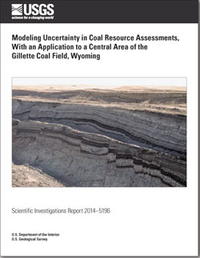Modeling uncertainty in coal resource assessments, with an application to a central area of the Gillette coal field, Wyoming
Links
- More information: USGS Index Page
- Document: Report (13.8 MB pdf)
- Download citation as: RIS | Dublin Core
Abstract
Standards for the public disclosure of mineral resources and reserves do not require the use of any specific methodology when it comes to estimating the reliability of the resources. Unbeknownst to most intended recipients of resource appraisals, such freedom commonly results in subjective opinions or estimations based on suboptimal approaches, such as use of distance methods. This report presents the results of a study of the third of three coal deposits in which drilling density has been increased one order of magnitude in three stages. Applying geostatistical simulation, the densest dataset was used to check the results obtained by modeling the sparser drillings. We have come up with two summary displays of results based on the same simulations, which individually and combined provide a better assessment of uncertainty than traditional qualitative resource classifications: (a) a display of cell 90 percent confidence interval versus cumulative cell tonnage, and (b) a histogram of total resources. The first graph allows classification of data into any number of bins with dividers to be decided by the assessor on the basis of a discriminating variable that is statistically accepted as a measure of uncertainty, thereby improving the quality and flexibility of the modeling. The second display expands the scope of the modeling by providing a quantitative measure of uncertainty for total tonnage, which is a fundamental concern for stockholders, geologists, and decision makers. Our approach allows us to correctly model uncertainty issues not possible to predict with distance methods, such as (a) different levels of uncertainty for individual beds with the same pattern and density of drill holes, (b) different local degrees of reduction of uncertainty with drilling densification reflecting fluctuation in the complexity of the geology, (c) average reduction in uncertainty at a disproportionately lesser rate than the reduction in area per drill hole, (d) the proportional effect of higher uncertainty in areas of higher tonnages, despite a regular drilling pattern, (e) the possibility of a local increase in uncertainty despite drilling densification to reflect a more complex geology as the deposit is known in more detail, and (f) for exactly the same drilling pattern, tonnage per individual beds with different uncertainty than the aggregated tonnage. These results should be considered realistic improvements over distance methods used for quantitative classification of uncertainty in coal resource, such as U.S. Geological Survey Circular 891.1 The approach should be a welcome addition to the toolkit of Competent Persons preparing public disclosures according to international mineral codes such as those promoted by the Combined Reserves International Reporting Standards Committee2 and the Joint Ore Reserve Committee.3
1 Wood, G.H., Jr., Kehn, T.M., Carter, M.D., and Culbertson, W.C., 1983, Coal resources classification system of the U.S. Geological Survey: U.S. Geological Survey Circular 891, 65 p.
2 CRIRSCO (Combined Reserves International Reporting Standards Committee), 2013, International reporting template for the public reporting of exploration results, mineral resources and mineral reserves: Accessed February 2014 at http://www.crirsco.com/crirsco_template_may2013.pdf.
3 JORC (Joint Ore Reserves Committee), 2012, Australasian code for reporting of exploration results, mineral resources and ore reserves: Accessed September 2014 at http://www.jorc.org/docs/jorc_code2012.pdf.
Study Area
| Publication type | Report |
|---|---|
| Publication Subtype | USGS Numbered Series |
| Title | Modeling uncertainty in coal resource assessments, with an application to a central area of the Gillette coal field, Wyoming |
| Series title | Scientific Investigations Report |
| Series number | 2014-5196 |
| DOI | 10.3133/sir20145196 |
| Year Published | 2014 |
| Language | English |
| Publisher | U.S. Geological Survey |
| Publisher location | Reston, VA |
| Contributing office(s) | Eastern Energy Resources Science Center |
| Description | v, 46 p. |
| Country | United States |
| State | Wyoming |
| Other Geospatial | Gillette Coal Field |
| Online Only (Y/N) | Y |
| Additional Online Files (Y/N) | N |


